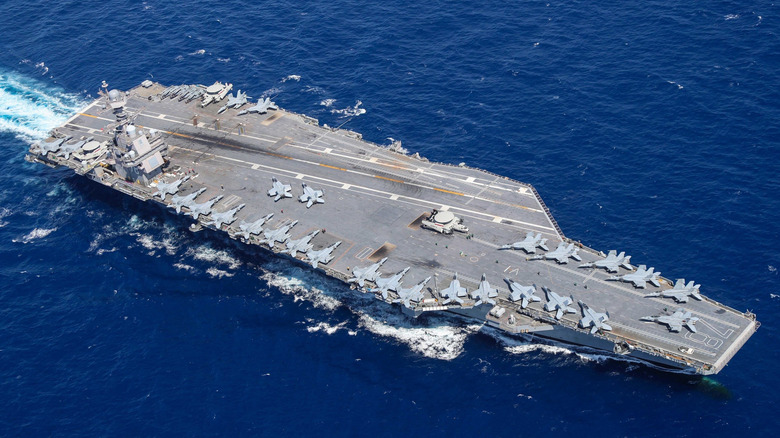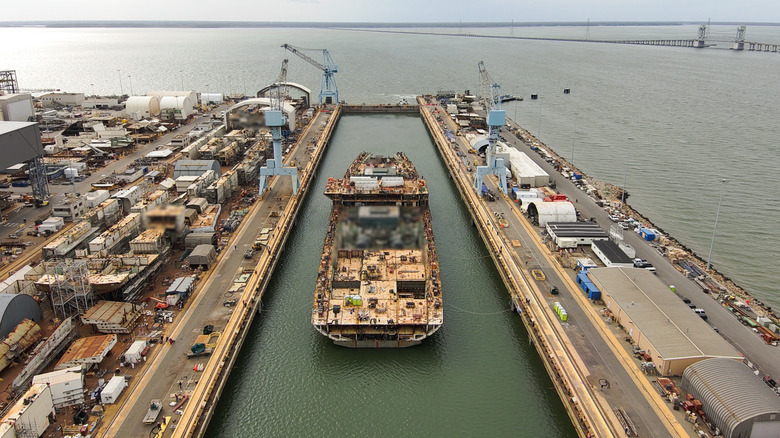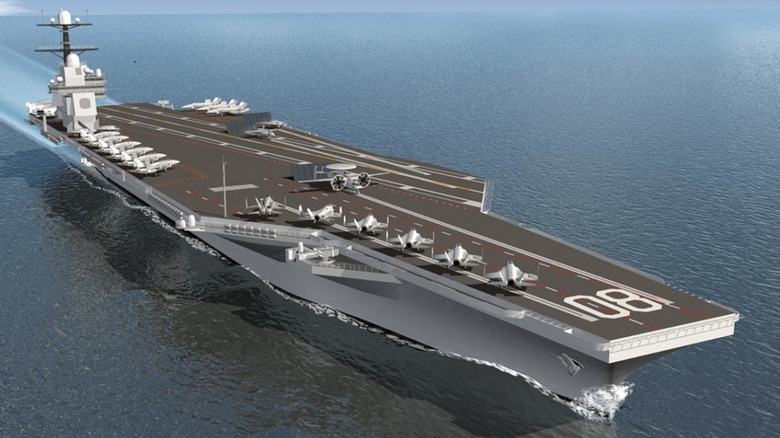USS Enterprise: Why America's Newest Aircraft Carrier Won't Launch For Years
The name "Enterprise" evokes a deep sense of naval pride and accomplishment in the U.S. defense history, and such is the legacy that nine Navy ships have worn that badge since 1775. The latest in the series is the USS Enterprise (CVN-80), a Gerald R. Ford-class aircraft carrier that officially entered the construction phase in 2019, but has since been beset by a series of delays. As per the latest projections, it will now be delivered in 2030.
"The CVN 80 delivery date shifted from September 2029 to July 2030 due to delays in material availability and industry/supply chain performance," says an unclassified report released by the Department of Defense, which documents the budget estimates allocated to the U.S. Navy for shipbuilding and conversion. The first notable delay was announced last year, when the commissioning date was pushed to September 2029, nearly a year and a half's worth of delay compared to the original target.
The setback was not entirely unexpected. Back in 2023, Huntington Ingalls Industries' (HII) Chief Chris Kastner told investors that due to component supply and labor shortage issues due to the pandemic, the delivery forecast was pushed by 12 months. In an official statement to Breaking Defense, HII's Newport News Shipbuilding unit added that the structural build of CVN 80 was behind schedule due to delays in the shipment of critical materials. The Navy's budget release confirmed it merely a few months later, pushing the delay from 18 to 26 months.
A string of crucial delays for the USS Enterprise
The USS Enterprise is the third ship in the USS Gerald R. Ford (CVN 78) class of aircraft carriers, and its First Cut of Steel ceremony was held back in 2017. Carrying forward the legacy of USS Enterprise (CVN 65), which was the world's first nuclear-powered aircraft carrier until its decommissioning in 2017, the reborn USS Enterprise forms the next-gen wave of the United States' naval carriers in the face of China's ever-growing naval might and the recent disturbances in the Indo-Pacific region.
The Gerald R. Ford class of carriers is supposed to offer over 50 years of service life, while delivering advanced combat and tactical capabilities and also reducing the ownership costs. Compared to the Nimitz-class carriers, these next-gen carriers come equipped with a propulsion system that generates thrice as much electrical power while reducing maintenance by a 30% margin. Purchased together with the unnamed CVN 81 in 2019, the USS Enterprise will come equipped with electromagnetic catapults for launching lightweight unmanned aircraft.
The USS Enterprise (CVN 80), however, is not the only carrier facing delays. The USS John F. Kennedy (CVN 79) and the USS Gerald R. Ford (CVN 78) are also facing delays in the queue. The DoD's report also highlights "longer supply chain lead times requiring additional funds in advance procurement." Simply put, supply chain issues are not the sole reason behind the delay. As was the case with the USS Gerald R. Ford, costs often balloon and delays happen due to the addition of new and advanced tech, as well.
What next for the USS Enterprise?
The USS Enterprise CVN 80 appears to be following a similar trajectory as the USS Gerald R. Ford supercarrier, which is eyeing a "basic construction" increase worth $435.55 million. As part of the increased budget allocated to the USS Enterprise (CVN 80), roughly $50 million will be set aside for the setup of an Unmanned Aviation Warfare Center (UAWC) that will help with recovery, intelligence, surveillance, reconnaissance (ISR), and refueling aboard the aircraft carrier.
Additionally, a Common Munitions Built-In-Test (BIT) and Reprogramming Equipment (CMBRE) will be added to assist with guidance and control of aerial weapons, while decreasing weapon movement and exposure time. Notably, the CCN 69 carrier received a refurbished AN/SPN-46 Automatic Carrier Landing System (ACLS), but due to the unavailability of another refurbished unit, the CVN 80 will get a new and fully automated precision approach landing system (PALS) at the cost of a few million dollars.
Similar is the situation with the I-Stalker system, which boosts situational awareness and provides a long-range, narrow field of view for identifying threats. Likewise, due to obsolescence issues, the Mk 2 (Mod 6E) computing infrastructure for the Integrated Combat System (ICS) was upgraded to the latest Mk 6 (Mod X) version, further ballooning up the costs and delivery. Furthermore, due to a decrease in the budget cuts worth around ten million dollars, it was decided that the USS Enterprise (CVN 80) would acquire its AN/USN-3(V)1 Satellite Signal Landing System (SSLS) from an existing fleet asset. It will certainly be a long wait.


